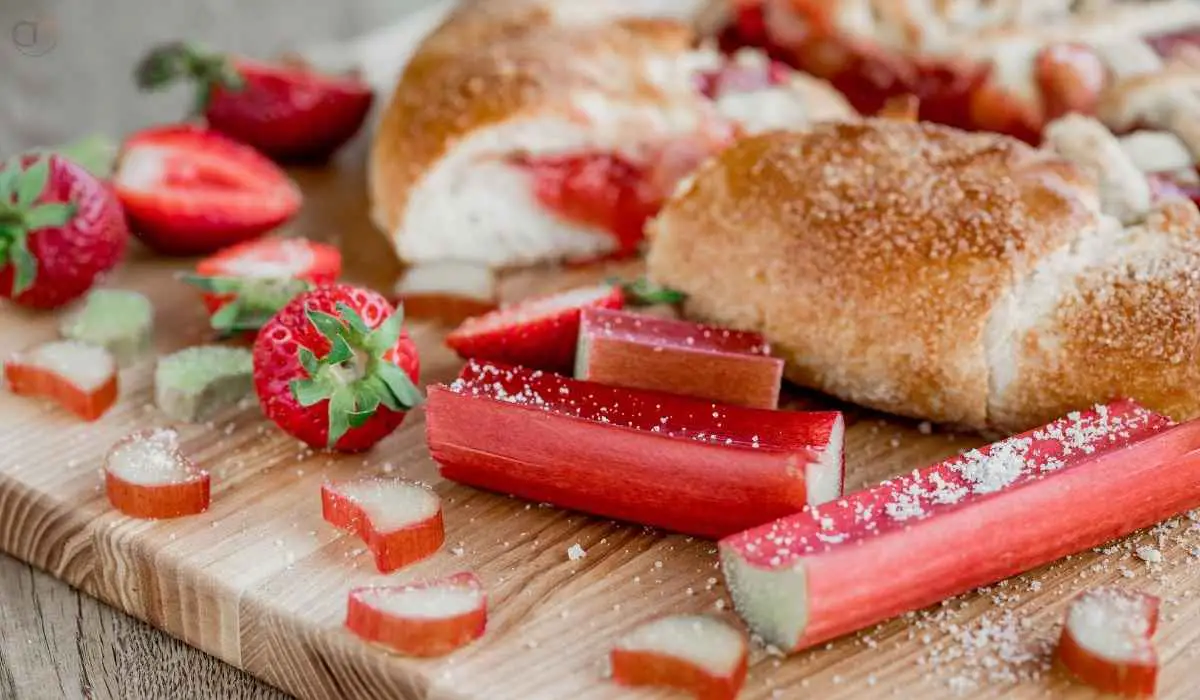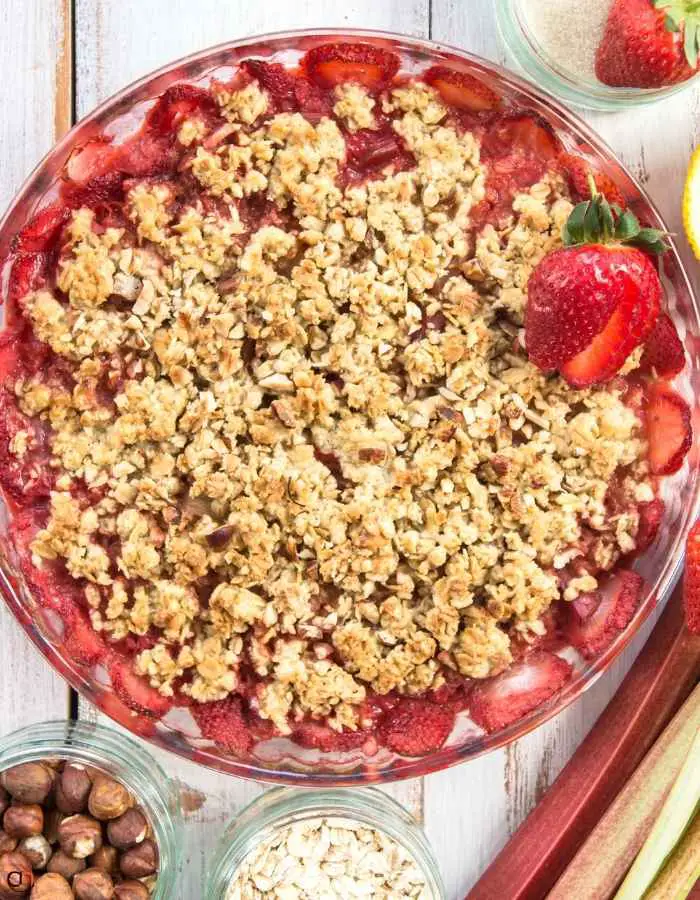Tart, vibrant, and wildly underrated—rhubarb is the unsung hero of spring and summer kitchens. Whether you’re baking it into a sweet pie, pairing it with strawberries, or exploring its savory potential, rhubarb brings a unique zing to any dish.
In this blog, we’re sharing mouthwatering Rhubarb Recipes that celebrate its bold flavor and seasonal charm. Enjoy classic crumbles to creative compotes, get ready to fall in love with rhubarb all over again.
What Is Rhubarb?
Rhubarb is a unique and vibrant vegetable often treated as a fruit in the kitchen due to its tart flavor and common use in desserts. Recognizable by its long, reddish stalks and celery-like appearance, rhubarb has a tangy taste that pairs beautifully with sweet ingredients like strawberries, sugar, and citrus.
Only the stalks are edible — the leaves are toxic and should always be discarded. With a growing season that peaks in spring and early summer, rhubarb is a favorite for pies, crumbles, jams, and even savory sauces. Rich in antioxidants, vitamin K, and fiber, it’s as nutritious as it is flavorful.
Tips for Cooking with Rhubarb:
-
Always Discard the Leaves: Rhubarb leaves contain oxalic acid and are toxic. Only use the stalks when cooking.
-
Balance the Tartness: Rhubarb is naturally very sour. Pair it with sweet ingredients like sugar, honey, strawberries, or apples to mellow the flavor.
-
Peel if Necessary: Older, thicker stalks may have tough, stringy skin. You can peel them lightly if needed for a smoother texture.
-
Cut Evenly: Chop rhubarb into uniform pieces to ensure even cooking, especially when baking or making compote.
-
Don’t Overcook: Rhubarb breaks down quickly. To maintain some texture, cook just until soft — especially for sauces or savory dishes.
-
Roasting Enhances Flavor: Try roasting rhubarb with a bit of sugar and orange zest to intensify its sweetness and reduce tartness without turning it to mush.
-
Freeze for Later: Rhubarb freezes well. Cut it into pieces, spread on a tray to freeze, then store in a bag for future use in pies, crisps, or sauces.
-
Pair with Warm Spices: Cinnamon, ginger, cardamom, and vanilla pair beautifully with rhubarb in both sweet and savory dishes.
2 Rhubarb Recipes Ideas;
Rhubarb adds a tart, tangy twist to both sweet and savory dishes, making it a versatile springtime favorite. Here are two easy and delicious Rhubarb Recipes you can whip up at home, step by step:
1. Strawberry Rhubarb Crisp
A cozy dessert with a golden oat topping and sweet-tart filling—perfect for early summer evenings.
Ingredients:
-
2 cups chopped rhubarb
-
2 cups chopped strawberries
-
¾ cup granulated sugar
-
1 tbsp cornstarch
-
1 tsp vanilla extract
-
Juice of ½ lemon
Topping:
-
¾ cup rolled oats
-
½ cup all-purpose flour
-
½ cup brown sugar
-
½ tsp cinnamon
-
6 tbsp cold butter, cubed
Instructions:
-
Preheat oven to 375°F (190°C).
-
Mix filling: In a bowl, combine rhubarb, strawberries, sugar, cornstarch, lemon juice, and vanilla.
-
Make topping: In another bowl, mix oats, flour, brown sugar, and cinnamon. Cut in butter until crumbly.
-
Assemble: Pour filling into a baking dish and spread topping evenly over it.
-
Bake for 35–40 minutes until golden and bubbly.
-
Serve warm with ice cream or whipped cream.
2. Rhubarb Chia Jam
This naturally sweetened, no-pectin jam is quick to make and perfect for spreading on toast or stirring into yogurt.
Ingredients:
-
2 cups chopped rhubarb
-
2 tbsp honey or maple syrup (adjust to taste)
-
2 tbsp water
-
1 tsp lemon juice
-
2 tbsp chia seeds
Instructions:
-
Simmer: In a small saucepan, combine rhubarb, water, and sweetener over medium heat. Cook for 10–12 minutes until rhubarb breaks down.
-
Mash: Use a fork or spoon to mash any large pieces.
-
Add chia & lemon: Stir in chia seeds and lemon juice, then simmer for 2–3 more minutes.
-
Cool: Let jam cool—it will thicken as it sets. Store in a jar in the fridge for up to 1 week.
-
Enjoy on toast, oatmeal, or pancakes!
Pairing Rhubarb with Other Ingredients:
Pairing rhubarb with the right ingredients can elevate its unique tart flavor and bring balance to any dish. Whether you’re making a dessert, drink, or savory meal, rhubarb blends beautifully with both sweet and bold flavors. Here are some classic and creative ingredient pairings:
1. Sweet Pairings
These ingredients help mellow rhubarb’s tartness and highlight its fruity profile:
-
Strawberries – the most iconic pairing; sweet and juicy
-
Apples or pears – add mellow sweetness and texture
-
Oranges – citrus brightness enhances rhubarb’s tang
-
Vanilla or almond extract – brings warmth and depth
-
Honey or maple syrup – natural sweeteners that balance acidity
2. Savory & Herb Pairings
Perfect for sauces, chutneys, and even main courses:
-
Ginger – spicy warmth that complements rhubarb’s sharpness
-
Mint or basil – adds freshness to salads or beverages
-
Onions & garlic – great in chutneys and savory jams
-
Pork or duck – fatty meats benefit from rhubarb’s acidity
-
Goat cheese or brie – creamy and tangy cheeses pair well in tarts or appetizers
3. Drink Pairings
Use rhubarb in drinks for a vibrant twist:
-
Sparkling water or soda – for rhubarb spritzers
-
Gin or vodka – in cocktails like rhubarb martinis or gimlets
-
Lemon or lime juice – to brighten and blend rhubarb syrups
Storage & Preservation Tips:
Proper storage and preservation of rhubarb can help maintain its vibrant flavor and firm texture long after harvesting. Whether you’re working with fresh stalks or have leftovers from a big batch of recipes, here are the best ways to keep your rhubarb fresh:
1. Refrigerating Fresh Rhubarb
-
Unwashed & Whole: Store unwashed rhubarb stalks in a plastic bag or wrap them in a damp paper towel, then place in the crisper drawer of your fridge. It will last up to 2 weeks.
-
Cut Rhubarb: If you’ve already chopped it, store it in an airtight container and use within 4–5 days.
2. Freezing Rhubarb
-
Prep: Wash and dry stalks, then slice into 1-inch pieces.
-
Blanching (optional): Blanch in boiling water for 1 minute, then cool in ice water to preserve color and texture.
-
Freeze: Spread pieces on a baking sheet in a single layer, freeze until solid, then transfer to freezer bags. Keeps well for up to 1 year.
3. Preserving Rhubarb (Long-Term Options)
-
Jam or Compote: Rhubarb’s high acidity makes it perfect for canning into jams or preserves.
-
Pickling: Quick-pickled rhubarb adds a tangy twist to savory dishes and can be stored in the fridge for weeks.
-
Dehydrating: Dried rhubarb strips make a tart, chewy snack and can be rehydrated for baking.
Key Take Away:
- Rhubarb is a tart, versatile plant that shines in both sweet and savory dishes.
- With proper storage—refrigerating, freezing, or preserving—it can be enjoyed year-round in everything from pies to pickles, & join us.
Read Next: 3 Healthy Food Dishes Ideas
FAQs:
1. Can I eat rhubarb raw?
Yes, but only the stalks. Rhubarb can be eaten raw, though it’s quite tart and usually sweetened. Never eat the leaves, as they are toxic.
2. How do I know if rhubarb has gone bad?
Spoiled rhubarb becomes soft, slimy, or discolored. If it smells off or has mold, it should be discarded.
3. Do I need to peel rhubarb?
Not usually. Young, tender rhubarb doesn’t need peeling. If the skin is thick or stringy, you can peel it for a smoother texture.
4. Is rhubarb a fruit or vegetable?
Botanically, it’s a vegetable—but in the kitchen, it’s often treated as a fruit due to its tart flavor and common use in desserts.
5. Can I grow rhubarb at home?
Yes! Rhubarb is easy to grow in cooler climates and returns year after year. It thrives in well-drained soil and partial to full sun.




